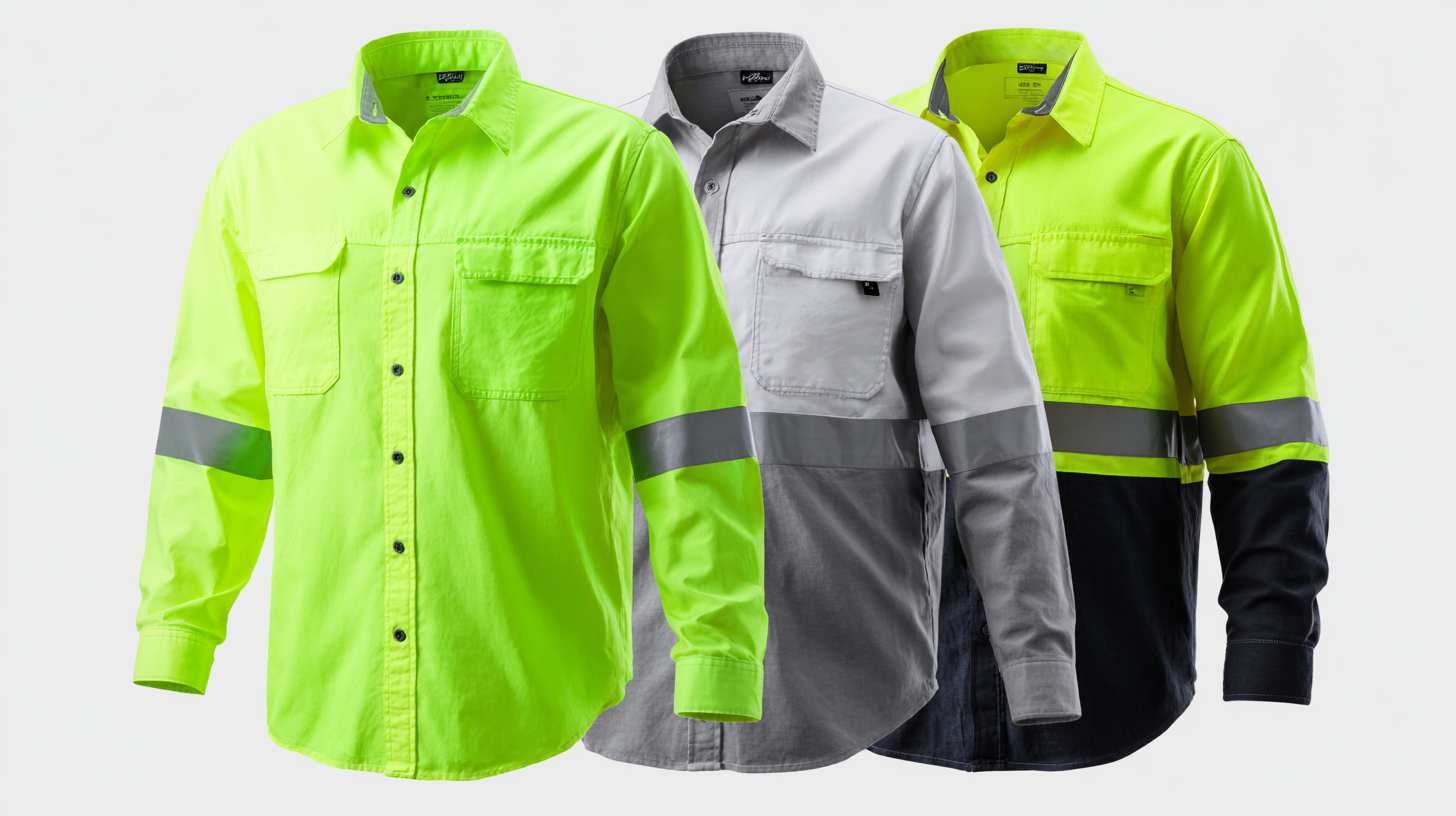In today's safety-conscious environment, Hi Vis Shirts play a critical role in enhancing visibility for workers across various industries, including construction, transportation, and emergency services. According to a report by the National Institute for Occupational Safety and Health (NIOSH), high-visibility apparel can significantly reduce the risk of accidents, with studies showing that neon-colored garments are visible from distances of up to 1,000 feet.

However, while traditional Hi Vis Shirts are essential, there is a growing interest in alternative options that provide similar safety features with added benefits of comfort and style. Innovations in materials and designs have led to the emergence of a variety of Hi Vis Shirt alternatives, each tailored for specific applications and environments.
This blog will explore the unique characteristics and practical uses of these alternatives, offering insights into how they can meet the diverse needs of today's workforce while maintaining safety as a top priority.
 In today's hazardous work environments, the demand for safety gear that combines
visibility with innovative functionality is ever-growing. Hi-Vis shirt alternatives, such as vests
and jackets, have emerged to enhance worker safety while providing additional features tailored to specific tasks.
These alternatives are often made from advanced materials that not only reflect
light but also wick moisture away from the body, ensuring comfort during long hours on the job. Some options even
incorporate built-in cooling technology, which helps to regulate body temperature
and reduce heat stress in high-temperature settings.
In today's hazardous work environments, the demand for safety gear that combines
visibility with innovative functionality is ever-growing. Hi-Vis shirt alternatives, such as vests
and jackets, have emerged to enhance worker safety while providing additional features tailored to specific tasks.
These alternatives are often made from advanced materials that not only reflect
light but also wick moisture away from the body, ensuring comfort during long hours on the job. Some options even
incorporate built-in cooling technology, which helps to regulate body temperature
and reduce heat stress in high-temperature settings.
Moreover, many of these Hi-Vis alternatives come equipped with strategically placed pockets and attachment points for tools,
enhancing their practicality. This thoughtful design allows workers to keep essential items easily accessible, minimizing downtime
and increasing efficiency. Additionally, the integration of moisture-resistant technologies ensures that workers remain
dry and visible, even in the toughest weather conditions. As industries continue to prioritize safety, the evolution of
Hi-Vis shirt alternatives exemplifies how innovation can make a significant difference
in the daily lives of workers in hazardous environments.
In the construction and engineering sectors, the integration of high-visibility (hi vis) alternatives is transforming safety standards and operational efficiency. Cases highlighting their effective use illustrate not just compliance with safety regulations but also a strategic response to emerging challenges. For instance, innovative materials designed for hi vis shirts can enhance visibility without compromising comfort, tailored for laborers facing harsh environmental conditions or extended work hours.
Moreover, the age of digital solutions, including cloud computing, is augmenting the application of these alternatives. With real-time data access and analysis, teams can quickly adapt their safety gear in response to evolving job site demands. As advancements in sustainable materials progress, the potential for eco-friendly hi vis alternatives becomes more viable, benefiting both worker safety and environmental sustainability.
Emphasizing these innovative approaches will ensure that safety practices in the construction industry are not only effective but also align with modern technological and environmental principles.
High visibility apparel plays a crucial role in enhancing safety within the road and traffic management industries. Workers who are constantly exposed to busy roadways must wear garments that ensure they are easily identifiable by passing vehicles. Traditional high visibility shirts often come with reflective strips and bright colors that catch the eye, but the market now offers a variety of alternatives that don’t compromise on safety while providing enhanced comfort and style. From moisture-wicking fabrics to breathable options, these alternatives are designed to meet the demands of diverse working conditions.
Understanding the source and manufacturing process of high visibility apparel is equally important. Supply chain transparency helps companies choose products that not only comply with safety standards but also align with their ethical values. Awareness about the materials used—whether sourced locally or imported—can significantly impact the decision-making process for businesses. In a world where sustainability is at the forefront, companies are more inclined to select apparel that is environmentally friendly, without sacrificing quality or performance. By exploring these unique features and applications of hi-vis alternatives, industries can reinforce their commitment to safety while remaining stylish and environmentally conscious.
In the context of exploring alternatives to traditional high-visibility (Hi Vis) shirts, a comparative analysis of cost efficiency and performance metrics reveals intriguing insights. Recent studies suggest that integrating sustainable materials in safety apparel not only enhances visibility but also contributes to environmental sustainability. For instance, the emerging trends in sustainable building materials indicate a shift towards using organic and recycled materials, which can be paralleled in apparel development. A report highlights that sustainable materials can reduce production costs by up to 30%, appealing to industries focused on cost efficiency.

Furthermore, similar to the advancements seen in biofuel production, where organic matter is harnessed for renewable energy, the textile industry is beginning to capitalize on bio-based fabrics that offer both functionality and eco-friendliness. A comparative analysis of different fabric technologies shows that these modern alternatives not only meet the necessary safety standards but also improve performance metrics such as breathability and moisture-wicking capabilities. Insights from the latest influencer marketing reports indicate that brands adopting innovative, sustainable approaches are likely to see improved return on investment, thereby driving a new market trend in high-visibility apparel.
When selecting the right Hi Vis shirt alternative for your industry needs, it's crucial to consider both functionality and sustainability. Recent industry reports highlight that the global demand for high-visibility apparel is expected to grow significantly, projected to reach over $3 billion by 2027. This demand is driven by increased awareness of safety in various sectors, including construction, road maintenance, and emergency services. However, the growing emphasis on sustainable practices has led to the evolution of Hi Vis alternatives—innovative products that not only meet safety requirements but also adhere to green manufacturing principles.
Incorporating eco-friendly materials is becoming standard practice within the industry, as reports indicate that sustainable textile production can reduce environmental impact by up to 30%. As companies shift towards responsible sourcing, choosing Hi Vis alternatives made from recycled fabrics or organic fibers not only fulfills safety regulations but also aligns with the increasing consumer preference for sustainable products. By prioritizing these features, industries can enhance worker safety while contributing to a healthier environment. When selecting these alternatives, businesses should pay attention to comfort, visibility standards, and the sustainability credentials of the fabrics to ensure they are meeting both safety and ethical expectations.
| Feature/Alternative | Material | Industry Use | Visibility Level | Additional Features |
|---|---|---|---|---|
| Reflective Vest | Polyester | Construction, Roadwork | High | Lightweight, Breathable |
| Hi Vis Polo Shirt | Cotton/Poly Blend | Warehousing, Logistics | Medium | Moisture-Wicking |
| Hi Vis Long Sleeve Shirt | 100% Polyester | Mining, Oil & Gas | High | UPF Protection |
| Hi Vis Hoodie | Fleece Blend | Emergency Services, Transit | Medium | Comfort & Warmth |
| Hi Vis Safety T-Shirt | Cotton | Manufacturing, Outdoor Work | High | Comfortable Fit |
